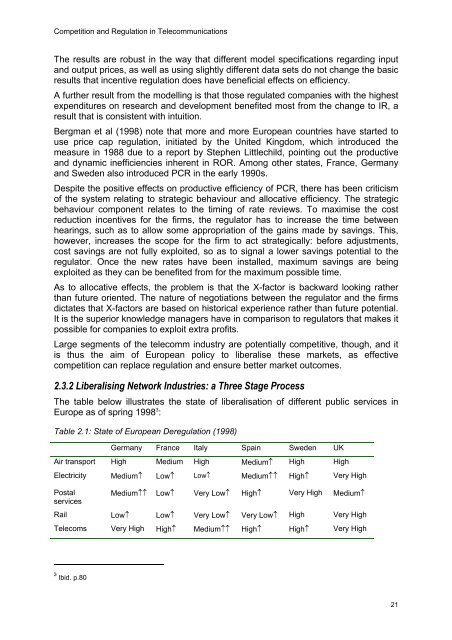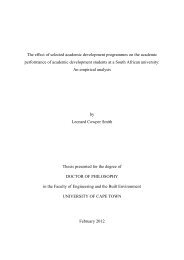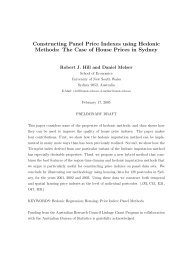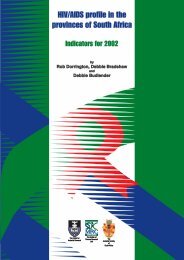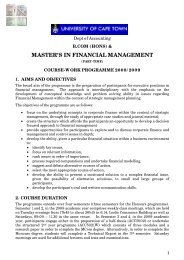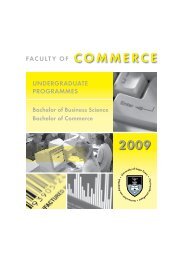Competition and Regulation in the Telecommunications Industry in ...
Competition and Regulation in the Telecommunications Industry in ...
Competition and Regulation in the Telecommunications Industry in ...
You also want an ePaper? Increase the reach of your titles
YUMPU automatically turns print PDFs into web optimized ePapers that Google loves.
<strong>Competition</strong> <strong>and</strong> <strong>Regulation</strong> <strong>in</strong> <strong>Telecommunications</strong>The results are robust <strong>in</strong> <strong>the</strong> way that different model specifications regard<strong>in</strong>g <strong>in</strong>put<strong>and</strong> output prices, as well as us<strong>in</strong>g slightly different data sets do not change <strong>the</strong> basicresults that <strong>in</strong>centive regulation does have beneficial effects on efficiency.A fur<strong>the</strong>r result from <strong>the</strong> modell<strong>in</strong>g is that those regulated companies with <strong>the</strong> highestexpenditures on research <strong>and</strong> development benefited most from <strong>the</strong> change to IR, aresult that is consistent with <strong>in</strong>tuition.Bergman et al (1998) note that more <strong>and</strong> more European countries have started touse price cap regulation, <strong>in</strong>itiated by <strong>the</strong> United K<strong>in</strong>gdom, which <strong>in</strong>troduced <strong>the</strong>measure <strong>in</strong> 1988 due to a report by Stephen Littlechild, po<strong>in</strong>t<strong>in</strong>g out <strong>the</strong> productive<strong>and</strong> dynamic <strong>in</strong>efficiencies <strong>in</strong>herent <strong>in</strong> ROR. Among o<strong>the</strong>r states, France, Germany<strong>and</strong> Sweden also <strong>in</strong>troduced PCR <strong>in</strong> <strong>the</strong> early 1990s.Despite <strong>the</strong> positive effects on productive efficiency of PCR, <strong>the</strong>re has been criticismof <strong>the</strong> system relat<strong>in</strong>g to strategic behaviour <strong>and</strong> allocative efficiency. The strategicbehaviour component relates to <strong>the</strong> tim<strong>in</strong>g of rate reviews. To maximise <strong>the</strong> costreduction <strong>in</strong>centives for <strong>the</strong> firms, <strong>the</strong> regulator has to <strong>in</strong>crease <strong>the</strong> time betweenhear<strong>in</strong>gs, such as to allow some appropriation of <strong>the</strong> ga<strong>in</strong>s made by sav<strong>in</strong>gs. This,however, <strong>in</strong>creases <strong>the</strong> scope for <strong>the</strong> firm to act strategically: before adjustments,cost sav<strong>in</strong>gs are not fully exploited, so as to signal a lower sav<strong>in</strong>gs potential to <strong>the</strong>regulator. Once <strong>the</strong> new rates have been <strong>in</strong>stalled, maximum sav<strong>in</strong>gs are be<strong>in</strong>gexploited as <strong>the</strong>y can be benefited from for <strong>the</strong> maximum possible time.As to allocative effects, <strong>the</strong> problem is that <strong>the</strong> X-factor is backward look<strong>in</strong>g ra<strong>the</strong>rthan future oriented. The nature of negotiations between <strong>the</strong> regulator <strong>and</strong> <strong>the</strong> firmsdictates that X-factors are based on historical experience ra<strong>the</strong>r than future potential.It is <strong>the</strong> superior knowledge managers have <strong>in</strong> comparison to regulators that makes itpossible for companies to exploit extra profits.Large segments of <strong>the</strong> telecomm <strong>in</strong>dustry are potentially competitive, though, <strong>and</strong> itis thus <strong>the</strong> aim of European policy to liberalise <strong>the</strong>se markets, as effectivecompetition can replace regulation <strong>and</strong> ensure better market outcomes.2.3.2 Liberalis<strong>in</strong>g Network Industries: a Three Stage ProcessThe table below illustrates <strong>the</strong> state of liberalisation of different public services <strong>in</strong>Europe as of spr<strong>in</strong>g 1998 3 :Table 2.1: State of European Deregulation (1998)Germany France Italy Spa<strong>in</strong> Sweden UKAir transport High Medium High Medium↑ High HighElectricity Medium↑ Low↑ Low↑ Medium↑↑ High↑ Very HighPostalservicesMedium↑↑ Low↑ Very Low↑ High↑ Very High Medium↑Rail Low↑ Low↑ Very Low↑ Very Low↑ High Very HighTelecoms Very High High↑ Medium↑↑ High↑ High↑ Very High3 Ibid. p.8021


